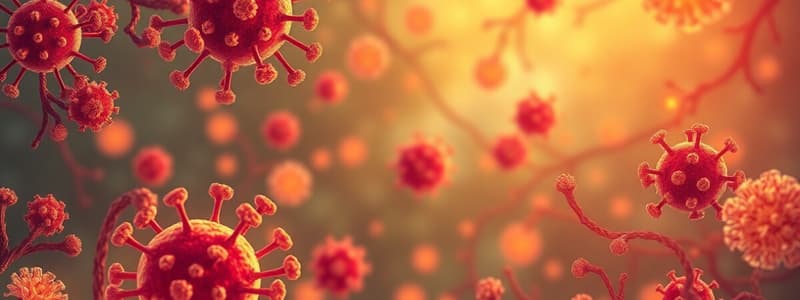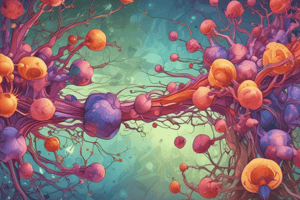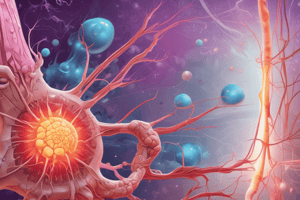Podcast
Questions and Answers
Which characteristic distinguishes acute inflammation from chronic inflammation?
Which characteristic distinguishes acute inflammation from chronic inflammation?
- The persistence of inflammation. (correct)
- The type of tissue damage that occurs.
- The initial trigger of the inflammatory response.
- The primary mediators involved.
In the context of cytokine regulation, what is the purpose of the short half-life of cytokines?
In the context of cytokine regulation, what is the purpose of the short half-life of cytokines?
- To enhance the efficiency of cytokine receptor binding.
- To facilitate cytokine transport to target tissues.
- To reduce the risk of inappropriate or excessive immune responses. (correct)
- To ensure cytokines are rapidly available for immune responses.
How does TNF-α contribute to acute inflammatory disease?
How does TNF-α contribute to acute inflammatory disease?
- By promoting immune cell migration and inducing the expression of adhesion molecules. (correct)
- By inhibiting leukocyte migration to inflammatory sites.
- By directly suppressing fever through the inhibition of PGE2 synthesis.
- By suppressing the expression of inflammatory cytokines.
What mechanism do both IL-1α and IL-1β employ to induce fever?
What mechanism do both IL-1α and IL-1β employ to induce fever?
Why is IL-8 important in acute inflammatory responses?
Why is IL-8 important in acute inflammatory responses?
What is a key characteristic of a cytokine storm?
What is a key characteristic of a cytokine storm?
What is the detrimental role of IL-6 in chronic inflammation?
What is the detrimental role of IL-6 in chronic inflammation?
How do glucocorticoids function as cytokine inhibitors?
How do glucocorticoids function as cytokine inhibitors?
What is the mechanism of action of aldesleukin in treating cancer?
What is the mechanism of action of aldesleukin in treating cancer?
Which of the following describes how cytokine inhibitors like methotrexate function?
Which of the following describes how cytokine inhibitors like methotrexate function?
Which of the following is a cytokine-based drug used to treat anemia?
Which of the following is a cytokine-based drug used to treat anemia?
Blocking IL-1 or TNF has shown success in treating which condition?
Blocking IL-1 or TNF has shown success in treating which condition?
Activation by cytokines occurs in what manner?
Activation by cytokines occurs in what manner?
Which cytokine has a role in the development of rheumatoid arthritis?
Which cytokine has a role in the development of rheumatoid arthritis?
If a patient has cancer and is neutropenic, what cytokine can be used to treat it?
If a patient has cancer and is neutropenic, what cytokine can be used to treat it?
Flashcards
Cytokines
Cytokines
Soluble factors secreted by immune cells that mediate inflammation
Aldesleukin
Aldesleukin
Interleukin-2 (IL-2) based drug, an immunotherapy for kidney cancer
Acute Inflammatory Cytokines
Acute Inflammatory Cytokines
Cytokines involved in the early stages of inflammation
Chronic Inflammatory Cytokines
Chronic Inflammatory Cytokines
Signup and view all the flashcards
Proinflammatory Cytokines
Proinflammatory Cytokines
Signup and view all the flashcards
Proinflammatory Cytokine Examples
Proinflammatory Cytokine Examples
Signup and view all the flashcards
Anti-Inflammatory Cytokines
Anti-Inflammatory Cytokines
Signup and view all the flashcards
Cytokine Regulation Importance
Cytokine Regulation Importance
Signup and view all the flashcards
Cytokine Storm
Cytokine Storm
Signup and view all the flashcards
Chronic Inflammatory Disease Examples
Chronic Inflammatory Disease Examples
Signup and view all the flashcards
Cytokines in Chronic inflammation
Cytokines in Chronic inflammation
Signup and view all the flashcards
Cytokine Inhibitor Drugs
Cytokine Inhibitor Drugs
Signup and view all the flashcards
Therapeutic Uses of Cytokine Blocking Antibodies
Therapeutic Uses of Cytokine Blocking Antibodies
Signup and view all the flashcards
Cytokine-Based Drugs
Cytokine-Based Drugs
Signup and view all the flashcards
Therapeutic uses of Cytokines
Therapeutic uses of Cytokines
Signup and view all the flashcards
Study Notes
- Cytokines - part II
Case Scenario
- Ellie (55) is being treated for kidney cancer that has spread.
- Her treatment includes a drug based on interleukin 2 (IL-2) known as aldesleukin.
- Aldesleukin is an immunotherapy drug with the brand name Proleukin.
Inflammatory Cytokines – Definition
- Inflammation is mediated by soluble factors, including secreted polypeptides known as cytokines.
- Inflammatory cytokines can be divided into acute inflammation and chronic inflammation.
- Inflammation is the response of tissue to injury.
- Acute phase inflammation is characterized by increased blood flow, vascular permeability, accumulation of fluid and leukocytes, and inflammatory mediators like cytokines.
Inflammatory Cytokines
- Cytokines mediate acute inflammatory reactions, including IL-1, TNF-a, IL-6, IL-11, IL-8, chemokines, G-CSF, and GM-CSF.
- Cytokines mediate chronic inflammatory processes in humoral inflammation, such as IL-3, IL-4, IL-5, IL-6, IL-7, IL-9, IL-10, IL-13, and transforming growth factor-b (TGF-b).
- Cytokines that contribute to cellular inflammation include IL-1, IL-2, IL-3, IL-4, IL-7, IL-9, IL-10, IL-12, interferons (IFNs), IFN-g-inducing factor (IGIF), TGF-b, TNF-a, and TNF-b.
Proinflammatory Cytokines
- Inflammatory abnormalities are a group of disorders underlying various human diseases.
- Cytokines regulate host responses to infection, immune responses, inflammation, and trauma.
- A proinflammatory cytokine promotes systemic inflammation.
- IL-1 and TNF alpha, (Interleukin (IL)-1 and tumor necrosis factor (TNF)) are examples.
- A proinflammatory cytokine is secreted from immune cells, such as helper T cells (Th) and macrophages and other cell types to promote inflammation.
Proinflammatory Cytokines
- Proinflammatory cytokines produce fever, inflammation, and tissue destruction.
- Biological activities of IL-1 and TNF are reduced by neutralizing antibodies, soluble receptors, receptor antagonists, and inhibitors of proteases that convert inactive precursors to active, mature molecules.
- Blocking IL-1 or TNF is successful in patients with rheumatoid arthritis, inflammatory bowel disease, and graft-vs-host disease.
Anti-Inflammatory Cytokines
- Anti-inflammatory cytokines are immunoregulatory molecules controlling the proinflammatory cytokine response.
- They act in concert with specific cytokine inhibitors and soluble cytokine receptors to regulate the immune response.
- Major anti-inflammatory cytokines include interleukin (IL)-1 receptor antagonist, IL-10, IL-11, IL-13, IL-4, and IL-6.
- Specific cytokine receptors for IL-1, tumor necrosis factor-alpha, and IL-18 function as proinflammatory cytokine inhibitors.
Cytokine Regulation
- Activation by cytokines is antigen-non-specific and must be regulated to avoid inappropriate responses.
- Cytokine action is regulated by transient production in response to antigens or inflammatory stimuli, short half-life in extracellular fluids, and restricted receptor expression profiles on activated and unactivated target cells.
- Cytokine dysregulation examples include the role of tumor necrosis factor alpha (TNFa) in developing rheumatoid arthritis.
- Blockade of TNF’s effect can be achieved through administration of recombinant soluble TNF-receptor or anti-TNF blocking antibody.
Cytokines in Acute Inflammatory Disease
- Cytokines play functions in mediating acute inflammatory reactions, namely IL-1, TNFα, IL-6, IL-11, IL-8, G-CSF, and GM-CSF.
- Leukocyte migration from peripheral blood to extravascular sites is key in the inflammatory response.
- TNFa is secreted by immune and parenchymal cells at inflammatory sites.
- TNFa promotes immune cell extravasation by activating endothelial cells to express adhesion molecules for immune cells.
- TNFa induces the expression of other inflammatory cytokines and chemokines.
- TNFa and IL-1 share pro-inflammatory properties, inducing fever by stimulating PGE2 synthesis in the hypothalamus or inducing release of IL-1.
Cytokines in Acute Inflammatory Disease
- The IL-1 family includes IL-1a and IL-1β, primarily produced by mononuclear phagocytes, fibroblasts, keratinocytes, and T and B lymphocytes.
- Like TNFa, IL-1 plays a function in inflammation.
- IL-1a and IL-1ẞ can trigger fever by enhancing prostaglandin E2 (PGE2) synthesis by the vascular endothelium in the hypothalamus and stimulate T cell proliferation.
- IL-1 elicits histamine release from mast cells at the inflammation site, triggering early vasodilation and increased vascular permeability.
- Neutrophil infiltration into inflammatory sites is one of acute inflammation's hallmarks.
- Local chemotactic factors mediate the sequence of events leading to infiltration at inflammatory sites.
- IL-8 is produced during inflammation and promotes neutrophil chemotaxis to the injury site.
Cytokine Storm
- Cytokines are involved in producing symptoms of infection like fever, inflammation, runny nose and aches/pains.
- Cytokine production can grow out of control.
- Immune cells release cytokines to produce more immune cells, leading to more pro-inflammatory cytokines.
- This positive feedback loop of cytokine creation can lead to a "cytokine storm.”
- A cytokine storm is an over-activation of immune cells, and over-production of their activating compounds.
- Can damage organs, especially the lungs and kidneys, and even lead to death.
- Severe cases of flu (suspected to be the main cause of death in the 1918 "Spanish Flu” pandemic) and sepsis are examples.
Chronic Inflammatory Disease
- Chronic inflammatory disease has persistent inflammation.
- Patients develop chronic inflammatory disease due to the immune system’s inappropriate response to external stimuli.
- Chronic inflammation causes tissue damage, a progressive shift in cell types, and simultaneous tissue destruction and healing.
- Examples of inflammatory diseases that become chronic: celiac disease, vasculitis, lupus, chronic obstructive pulmonary disease (COPD), irritable bowel disease, atherosclerosis, arthritis, and psoriasis.
Chronic Inflammatory Disease
- Several cytokines are key in mediating chronic inflammatory reactions, including IL3, IL6, TNFẞ, IL4, IL5, IL7, IL9, IL10, IL13, IL14, and IFN.
- IL6 is produced at the inflammation site.
- IL-6 mediates acute phase responses at acute inflammation onset.
- When its activity as a pro-inflammatory cytokine persists, acute inflammation turns into chronic inflammation.
- In chronic inflammation, IL-6 promotes mononuclear cell accumulation at the injury site through continuous MCP-1 secretion, angioproliferation, and anti-apoptotic functions on T cells.
- Continuos expression of IL-6 increases serum levels and it amplifies chronic inflammatory proliferation.
- Plasmacytosis and hyperplasia of synovial cells in the joints of patients with rheumatoid arthritis (RA) are the product of chronic inflammatory proliferation.
Cytokine Inhibitor Drugs
- One aspect of cytokine inhibitor drugs include the:
- Reduction of cytokine producing cells.
- This decreases number of cytokine producing cells and inhibits cytokine synthesis.
- An example is methotrexate - Inhibits activation of T cells, rheumatoid arthritis, PH3113
- Some drugs do not affect viability of cells. Cytokine synthesis can be inhibited without affecting viability of cells.
- An example is glucocorticoids (e.g., prednisone), which acts as an anti-inflammatory or immunosuppressive by inhibiting interleukin-1, tumor necrosis factor or interleukin-2.
- Monoclonal antibody against cytokines also inhibit function.
- Infliximab is an example of an antibody directed against TNFa (tumor necrosis factor) for autoimmune disorders.
Therapeutic Uses of Cytokine Blocking Antibodies
- Anti-cytokine antibodies benefit autoimmune diseases and transplant rejection.
- Anti-TNF-a can treat Rheumatoid Arthritis.
- Anti-IL-2R can treat Graft rejection
- Anti-Il-6 antibodies can treat Rheumatoid arthritis and Covid-19.
Cytokine-Based Drugs
- Cytokine-based drugs stimulate the immune response.
- Erythropoietin (EPO) is used to treat anemia.
- Granulocyte colony-stimulating factor (G-CSF) is used to treat neutropenia in cancer patients.
- Interferon alpha (INF-a) is used to treat hepatitis C and multiple sclerosis.
- Interferon beta (INF-b) treats multiple sclerosis.
- Interleukin 11 (IL-11) treats thrombocytopenia in cancer patients.
- Interleukin 2 (IL-2), also known as Aldesleukin, treats cancer.
Therapeutic Uses of Cytokines - Overview
- INT is a therapeutic drug for treating viral diseases, and cancer.
- IL-2, INF-g and TNF-a can enhance T cell activation in immunodeficiency.
- II-2 can treat T-cell proliferation causing Cancer
- GM-CSF induces an increase in leukocyte blood count.
- It is used to restore leukocyte count after cytotoxic chemotherapy
- It is also used after bone marrow transplantation to correct AIDS-associated leukopenia
Case Scenario: Aldesleukin
- Aldesleukin is very similar to the cytokine interleukin-2 (IL-2).
- Interleukin-2 is part of the body’s immune system.
- The body normally produces IL-2 which is secreted by T cells, to stimulate growth and differentiation of the T cell response.
- Aldesleukin works by:
- Induction the enhancement of lymphocyte mitogenesis and stimulation of long-term growth of human interleukin-2 dependent cell lines.
- Enhancement of lymphocyte cytotoxicity, the induction of killer cell (lymphokine-activated (LAK) and natural (NK)) activity
- Induction of interferon-gamma production.
Mechanism of Action
- Aldesleukin (high-dose II-2) binds to the IL-2 receptor; this leads to heterodimerization of the cytoplasmic domains of the IL-2R beta and gamma(c) chains.
- Activation of the tyrosine kinase Jak3, and phosphorylation of tyrosine residues on the IL-2R beta chain.
- These events lead to the creation of an activated IL-2R receptor complex.
- IL-2R signalling triggers three distinct pathways.
- These events stimulate growth and differentiation of II-2 dependent T cells.
Studying That Suits You
Use AI to generate personalized quizzes and flashcards to suit your learning preferences.




